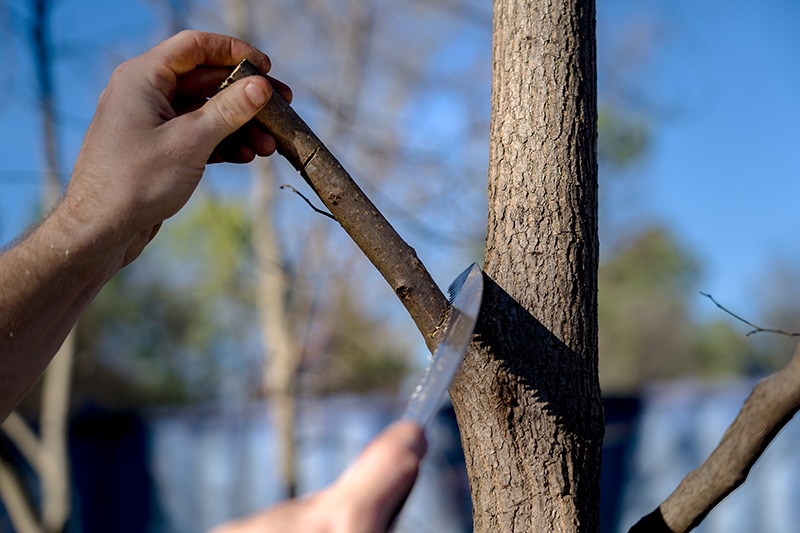When it comes to pruning trees, knowing when to switch from loppers to a saw is crucial. If you encounter a branch that is too thick for loppers, it’s time to use a saw and employ either a two or three-cut technique. Simply cutting down from the top of a branch can lead to serious problems. As you near the end of the cut, the branch’s weight can cause it to drop suddenly, potentially tearing the bark down the trunk. This damage creates an entry point for canker disease and leaves an unsightly mark on your tree.
To avoid this, always start your first cut from the bottom of the branch and move upwards until you cut through the bark. For smaller branches that you can manage easily, the two-cut method is sufficient. However, for larger, heavier branches that could become unwieldy, the three-cut method is recommended for safe removal.
Here’s how to execute the three-cut method: First, make an upward cut about one to two feet from the main trunk, cutting through the bark. Next, make a second cut from the top down to intersect with the first cut. This step removes most of the weight from the end of the branch. Once the weight is gone, you can safely cut down from the top to remove the remaining lightweight stump.
Where you make the cuts is just as important as how you make them. In the past, flush cuts—where the cut is parallel to the trunk—were thought to be ideal. However, research has shown that flush cuts can hinder the tree’s natural healing process. Instead, aim to make cuts between the shoulder rings, which are narrow ridges found where a major branch meets the trunk. This technique leaves a slight stub and allows the tree to form callus tissue more quickly and effectively.
Remember, tree pruning is an essential part of maintaining your landscape, but it should be done with care and knowledge. Always consider consulting your local Cooperative Extension Service for the most current and localized recommendations before undertaking any significant pruning tasks. Happy pruning! 🌿✨


Thank you for your sharing. I am worried that I lack creative ideas. It is your article that makes me full of hope. Thank you. But, I have a question, can you help me?
Thanks for sharing. I read many of your blog posts, cool, your blog is very good.
Reading your article has greatly helped me, and I agree with you. But I still have some questions. Can you help me? I will pay attention to your answer. thank you.
Das MGM Grand bietet eine beeindruckende Auswahl an gastronomischen Einrichtungen,
darunter preisgekrönte Restaurants und verschiedene Bars.
Die Wohneinheiten im MGM Grand sind modern und klassisch eingerichtet
und bieten den Gästen allen Komfort, den sie sich wünschen. Die
berühmte Fremont Street Experience ist etwa 12 km entfernt und
die University of Nevada in Las Vegas erreichen Sie in nur 10 Fahrminuten.
Das Casino des Hotels ist eines der größten Casinos
in ganz Vegas. Die Skylofts haben meist mehrere Schlafzimmer und Badezimmer.
Zur Zeit ist es immerhin noch der drittgrößte Hotelkomplex der
Welt. Das MGM Grand Hotel und Casino Resort in Las Vegas war zum
Zeitpunkt seiner Eröffnung das größte Hotel der Welt.
Mit 5.044 Zimmern gilt es als drittgrößtes Hotel der Welt.
Das Hotel verfügt über 30 Etagen mit einer Reihe verschiedener Möglichkeiten, um die Hitze von Nevada
zu besiegen, darunter 5 Außenpools und Wasserspiele wie Flüsse und Wasserfälle, die insgesamt 6,6 Hektar Land bedecken. Eure
Abende könnt ihr im hoteleigenen Casino oder den Nachtclubs des
Resorts verbringen. Eine Nacht im Doppelzimmer mit
Kingsize Bett bekommt ihr im MGM ab 89 €. Für besonders
gehobene Ansprüche bietet das Hotel 29 private Villen an. Dieser umfasst fünf Schwimmbecken, einen Strömungskanal und
drei Whirlpools. Das im japanischen Stil gehaltene Wellnesscenter bietet neben verschiedenen Massagen auch Air-Bräunung,
Gesichtsbehandlungen, Maniküre und Pediküre an.
References:
https://online-spielhallen.de/alles-zur-kings-casino-auszahlung-schnell-sicher-und-transparent/